Inhibition Effect of Chloroquine and Integrin-Linked Kinase Knockdown on Translation in Melanoma Cells
Abstract
1. Introduction
2. Results
2.1. Silencing of ILK and Chloroquine Inhibits the Survival of Melanoma Cells
2.2. Knockdown of ILK-Induced Autophagy
2.3. ILK Inhibits AMPK-Dependent Autophagy
2.4. ILK Knockdown is Sufficient to Induce Autophagy Through Regulation of ULK1 Activity
2.5. mTOR Activity Regulated by ILK and Chloroquine
2.6. Targeting the Translational Machinery by Silencing ILK, CQ, and Combination Treatment
2.7. Migration
3. Discussion
4. Materials and Methods
4.1. Cell Culture
4.2. Cell Culture Treatment
4.3. Western Blot Analysis
4.4. Monitoring Autophagy in the Cell
4.5. Proliferation
4.6. In Vitro Wound Healing/Migration Assay
4.7. Statistical Analysis
Author Contributions
Funding
Institutional Review Board Statement
Informed Consent Statement
Data Availability Statement
Acknowledgments
Conflicts of Interest
References
- Yun, C.W.; Lee, S.H. The roles of autophagy in cancer. Int. J. Mol. Sci. 2018, 19, 3466. [Google Scholar] [CrossRef] [PubMed]
- Marinković, M.; Šprung, M.; Buljubašić, M.; Novak, I. Autophagy Modulation in Cancer: Current Knowledge on Action and Therapy. Oxid. Med. Cell Longev. 2018, 31, 8023821. [Google Scholar] [CrossRef] [PubMed]
- Saha, S.; Panigrahi, D.P.; Patil, S.; Bhutia, S.K. Autophagy in health and disease: A comprehensive review. Biomed. Pharmacother. 2018, 104, 485–495. [Google Scholar] [CrossRef] [PubMed]
- Amaravadi, R.; Kimmelman, A.C.; White, E. Recent insights into the function of authophagy in cancer. Genes Dev. 2016, 30, 1913–1930. [Google Scholar] [CrossRef]
- Alvarez-Meythaler, J.G.; Garcia-Mayea, Y.; Mir, C.; Kondoh, H.; LLeonart, M.E. Autophagy Takes Center Stage as a Possible Cancer Hallmark. Front Oncol. 2020, 10, 586069. [Google Scholar] [CrossRef] [PubMed]
- Yun, C.W.; Jeon, J.; Go, G.; Lee, J.H.; Lee, S.H. The Dual Role of Autophagy in Cancer Development and a Therapeutic Strategy for Cancer by Targeting Autophagy. Int. J. Mol. Sci. 2020, 22, 179. [Google Scholar] [CrossRef]
- Ndoye, A.; Weeraratna, A.T. Autophagy—An emerging target for melanoma therapy. F1000Research 2016, 5. [Google Scholar] [CrossRef]
- Truong, A.; Yoo, J.H.; Scherzer, M.T.; Sanchez, J.M.S.; Dale, K.J.; Kinsey, C.G.; Richards, J.R.; Shin, D.; Ghazi, P.C.; Onken, M.D.; et al. Chloroquine Sensitizes GNAQ/11-mutated Melanoma to MEK1/2 Inhibition. Clin. Cancer Res. 2020, 26, 6374–6386. [Google Scholar] [CrossRef]
- Mauthe, M.; Orhon, I.; Rocchi, C.; Zhou, X.; Luhr, M.; Hijlkema, K.J.; Coppes, R.P.; Engedal, N.; Mari, M.; Reggiori, F. Chloroquine inhibits autophagic flux by decreasing autophagosome-lysosome fusion. Autophagy 2018, 14, 1435–1455. [Google Scholar] [CrossRef]
- Verbaanderd, C.; Maes, H.; Schaaf, M.B.; Sukhatme, V.P.; Pantziarka, P.; Sukhatme, V.; Agostinis, P.; Bouche, G. Repurposing Drugs in Oncology (ReDO)—Chloroquine and hydroxychloroquine as anti-cancer agents. Ecancermedicalscience 2017, 11, 781. [Google Scholar] [CrossRef]
- Jia, L.; Wang, J.; Wu, J.; Ling, J.; Cheng, B. In vitro and in vivo effects of chloroquine on oral squamous cell carcinoma. Mol. Med. Rep. 2017, 16, 5779–5786. [Google Scholar] [CrossRef]
- Lin, Y.C.; Lin, J.F.; Wen, S.I.; Yang, S.C.; Tsai, T.F.; Chen, H.E.; Chou, K.Y.; Hwang, T.I. Chloroquine and hydroxychloroquine inhibit bladder cancer cell growth by targeting basal autophagy and enhancing apoptosis. Kaohsiung J. Med. Sci. 2017, 33, 215–223. [Google Scholar] [CrossRef]
- Lakhter, A.J.; Sahu, R.P.; Sun, Y.; Kaufmann, W.K.; Androphy, E.J.; Travers, J.B.; Naidu, S.R. Chloroquine promotes apoptosis in melanoma cells by inhibiting BH3 domain-mediated PUMA degradation. J. Investig. Dermatol. 2013, 133, 2247–2254. [Google Scholar] [CrossRef]
- Maes, H.; Kuchnio, A.; Peric, A.; Moens, S.; Nys, K.; De Bock, K.; Quaegebeur, A.; Schoors, S.; Georgiadou, M.; Wouters, J.; et al. Tumor vessel normalization by chloroquine independent of autophagy. Cancer Cell 2014, 26, 190–206. [Google Scholar] [CrossRef]
- Liu, T.; Zhang, J.; Li, K.; Deng, L.; Wang, H. Combination of an Autophagy Inducer and an Autophagy Inhibitor: A Smarter Strategy Emerging in Cancer Therapy. Front. Pharmacol. 2020, 11, 408. [Google Scholar] [CrossRef] [PubMed]
- Egger, M.E.; Huang, J.S.; Yin, W.; McMasters, K.M.; McNally, L.R. Inhibition of autophagy with chloroquine is effective in melanoma. J. Surg. Res. 2013, 184, 274–281. [Google Scholar] [CrossRef] [PubMed]
- McDonald, P.C.; Fielding, A.B.; Dedhar, S. Integrin-linked kinase—Essential roles in physiology and cancer biology. J Cell Sci. 2008, 121, 3121–3132. [Google Scholar] [CrossRef] [PubMed]
- Zheng, C.C.; Hu, H.F.; Hong, P.; Zhang, Q.H.; Xu, W.W.; He, Q.Y.; Li, B. Significance of integrin-linked kinase (ILK) in tumorigenesis and its potential implication as a biomarker and therapeutic target for human cancer. Am. J. Cancer Res. 2019, 9, 186–197. [Google Scholar]
- Gil, D.; Ciołczyk-Wierzbicka, D.; Dulińska-Litweka, J.; Zwawa, K.; McCubrey, J.A.; Laidler, P. The mechanism of contribution of integrin linked kinase (ILK) to epithelial-mesenchymal transition (EMT). Adv. Enzyme Regul. 2011, 51, 195–207. [Google Scholar] [CrossRef] [PubMed]
- Gil, D.; Ciołczyk-Wierzbicka, D.; Dulińska-Litewka, J.; Laidler, P. Integrin-linked kinase regulates cadherin switch in bladder cancer. Tumor Biol. 2016, 37, 15185–15191. [Google Scholar] [CrossRef]
- Gil, D.; Zarzycka, M.; Ciołczyk-Wierzbicka, D.; Laidler, P. Integrin linked kinase regulates endosomal recycling of N-cadherin in melanoma cells. Cell Signal. 2020, 72, 109642. [Google Scholar] [CrossRef]
- Yau, C.Y.; Wheeler, J.J.; Sutton, K.L.; Hedley, D.W. Inhibition of integrin-linked kinase by a selective small molecule inhibitor, QLT0254, inhibits the PI3K/PKB/mTOR, Stat3, and FKHR pathways and tumor growth, and enhances gemcitabine-induced apoptosis in human orthotopic primary pancreatic cancer xenografts. Cancer Res. 2005, 65, 1497–1504. [Google Scholar]
- McDonald, P.C.; Oloumi, A.; Mills, J.; Dobreva, I.; Maidan, M.; Gray, V.; Wederell, E.D.; Bally, M.B.; Foster, L.J.; Dedhar, S. Rictor and integrin-linked kinase interact and regulate Akt phosphorylation and cancer cell survival. Cancer Res. 2008, 68, 1618–1624. [Google Scholar] [CrossRef]
- Tian, T.; Li, X.; Zhang, J. mTOR Signaling in Cancer and mTOR Inhibitors in Solid Tumor Targeting Therapy. Int. J. Mol. Sci. 2019, 20, 755. [Google Scholar] [CrossRef]
- Wong, R.P.; Ng, P.; Dedhar, S.; Li, G. The role of integrin-linked kinase in melanoma cell migration, invasion, and tumor growth. Mol. Cancer Ther. 2007, 6, 1692–1700. [Google Scholar] [CrossRef]
- Boulares, A.H.; Yakovlev, A.G.; Ivanova, V.; Stoica, B.A.; Wang, G.; Iyer, S.; Smulson, M. Role of poly(ADP-ribose) polymerase (PARP) cleavage in apoptosis. Caspase 3-resistant PARP mutant increases rates of apoptosis in transfected cells. J. Biol. Chem. 1999, 274, 22932–22940. [Google Scholar] [CrossRef] [PubMed]
- Singh, B.; Bhaskar, S. Methods for Detection of Autophagy in Mammalian Cells. Methods Mol. Biol. 2019, 2045, 245–258. [Google Scholar] [CrossRef] [PubMed]
- Cheng, J.; Zhang, T.; Ji, H.; Tao, K.; Guo, J.; Wei, W. Functional characterization of AMP-activated protein kinase signaling in tumorigenesis. Biochim. Biophys. Acta 2016, 1866, 232–251. [Google Scholar] [CrossRef]
- Spears, L.D.; Tran, A.V.; Qin, C.Y.; Hobbs, S.B.; Burns, C.A.; Royer, N.K.; Zhang, Z.; Ralston, L.; Fisher, J.S. Chloroquine increases phosphorylation of AMPK and Akt in myotubes. Heliyon 2016, 2, e00083. [Google Scholar] [CrossRef]
- Kim, J.; Kondu, M.; Violeet, B.; Guan, K.-L. AMPK and mTOR regulate autophagy through direct phosphorylation of ULK1. Nat. Cell Biol. 2011, 13, 132–141. [Google Scholar] [CrossRef] [PubMed]
- Tian, W.; Li, W.; Chen, Y.; Yan, Z.; Huang, X.; Zhuang, H.; Zhong, W.; Chen, Y.; Wu, W.; Lin, C.; et al. Phosphorylation of ULK1 by AMPK regulates translocation of ULK1 to mitochondria and mitophagy. FEBS Lett. 2015, 589, 1847–1854. [Google Scholar] [CrossRef] [PubMed]
- Romanelli, A.; Dreisbach, V.C.; Blenis, J. Characterization of phosphatidylinositol 3-kinase-dependent phosphorylation of the hydrophobic motif site Thr(389) in p70 S6 kinase 1. J. Biol. Chem. 2002, 277, 40281–40289. [Google Scholar] [CrossRef] [PubMed]
- Martelli, A.M.; Buontempo, F.; McCubrey, J.A. Drug discovery targeting the mTOR pathway. Clin. Sci. 2018, 132, 543–568. [Google Scholar] [CrossRef]
- Gao, B.; Roux, P.P. Translational control by oncogenic signaling pathways. Biochim. Biophys. Acta Gene Regul. Mech. 2015, 1849, 753–765. [Google Scholar] [CrossRef]
- Proud, C.G. Mnks, eIF4E phosphorylation and cancer. Biochim. Biophys. Acta Gene Regul. Mech. 2015, 1849, 766–773. [Google Scholar] [CrossRef] [PubMed]
- Lineham, E.; Tizzard, G.J.; Coles, S.J.; Spencer, J.; Morley, S.J. Synergistic effects of inhibiting the MNK-eIF4E and PI3K/AKT/ mTOR pathways on cell migration in MDA-MB-231 cells. Oncotarget 2018, 9, 14148–14159. [Google Scholar] [CrossRef]
- Baird, T.D.; Wek, R.C. Eukaryotic initiation factor 2 phosphorylation and translational control in metabolism. Adv. Nutr. 2012, 3, 307–321. [Google Scholar] [CrossRef]
- Sosa, P.; Alcalde-Estevez, E.; Plaza, P.; Troyano, N.; Alonso, C.; Martínez-Arias, L.; Evelem de Melo Aroeira, A.; Rodriguez-Puyol, D.; Olmos, G.; López-Ongil, S.; et al. Hyperphosphatemia promotes senescence of myoblasts by impairing autophagy through ILK overexpression, a possible mechanism involved in sarcopenia. Aging Dis. 2018, 9, 769–784. [Google Scholar] [CrossRef]
- Pang, M.; Wang, H.; Rao, P.; Zhao, Y.; Xie, J.; Cao, Q.; Wang, Y.; Wang, Y.M.; Lee, V.W.; Alexander, S.I.; et al. Autophagy links β-catenin and Smad signaling to promote epithelial-mesenchymal transition via upregulation of integrin linked kinase. Int. J. Biochem. Cell Biol. 2016, 76, 23–34. [Google Scholar] [CrossRef]
- Chen, H.-T.; Liu, H.; Mao, M.-J.; Yuan, T.; Mo, X.-Q.; Meng, X.-J.; Cao, M.-T.; Zhong, C.-Y.; Liu, Y.; Shan, H. Crosstalk between autophagy and epithelial-mesenchymal transition and its application in cancer therapy. Mol. Cancer 2019, 18, 101. [Google Scholar] [CrossRef]
- Acevo-Rodríguez, P.S.; Maldonado, G.; Castro-Obregón, S.; Hernández, G. Autophagy Regulation by the Translation Machinery and Its Implications in Cancer. Front. Oncol. 2020, 10, 322. [Google Scholar] [CrossRef] [PubMed]
- Bitterman, P.B.; Plunovsky, V.A. eIF4E-mediated translational control of cancer incidence. Biochim. Biophys. Acta Gene Regul. Mech. 2015, 1849, 774–780. [Google Scholar] [CrossRef]
- Prabhu, S.A.; Moussa, O.; Miller, W.H., Jr.; del Rincon, S. The MNK1/2-eIF4E axis as a potential therapeutic target in melanoma. Int. J. Mol. Sci. 2020, 21, 4055. [Google Scholar] [CrossRef]
- Holcik, M. Could the eIF2α-independent translation be the Achilles heel of cancer? Front. Oncol. 2015, 5, 264. [Google Scholar] [CrossRef] [PubMed]
- Wengrod, J.; Wang, D.; Weiss, S.; Zhong, H.; Osman, I.; Gardner, L.B. Phosphorylation of eIF2α by mTORC1 inhibition and PP6C activation is required for autophagy and is aberrant inPP6C- mutated melanoma. Sci. Signal. 2015, 8, ra27. [Google Scholar] [CrossRef] [PubMed]
- Serrano, I.; McDonald, P.C.; Lock, F.E.; Dedhar, S. Role of the integrin-linked kinase ILJK/Rictor complex in TGFβ-1-induced epithetlial-mesenchymal transition (EMT). Oncogene 2013, 32, 50–60. [Google Scholar] [CrossRef] [PubMed]
- Zhao, D.; Jiang, M.; Zhang, X.; Hou, H. The role of RICTOR amplification in targeted therapy and drug resistance. Mol. Med. 2020, 26, 20. [Google Scholar] [CrossRef]
- Ciołczyk-Wierzbicka, D.; Gil, D.; Laidler, P. The inhibition of cell proliferation using of N-cadherin gene by siRNA proces in human melanoma cell lines. Curr. Med. Chem. 2012, 19, 145–151. [Google Scholar] [CrossRef] [PubMed]
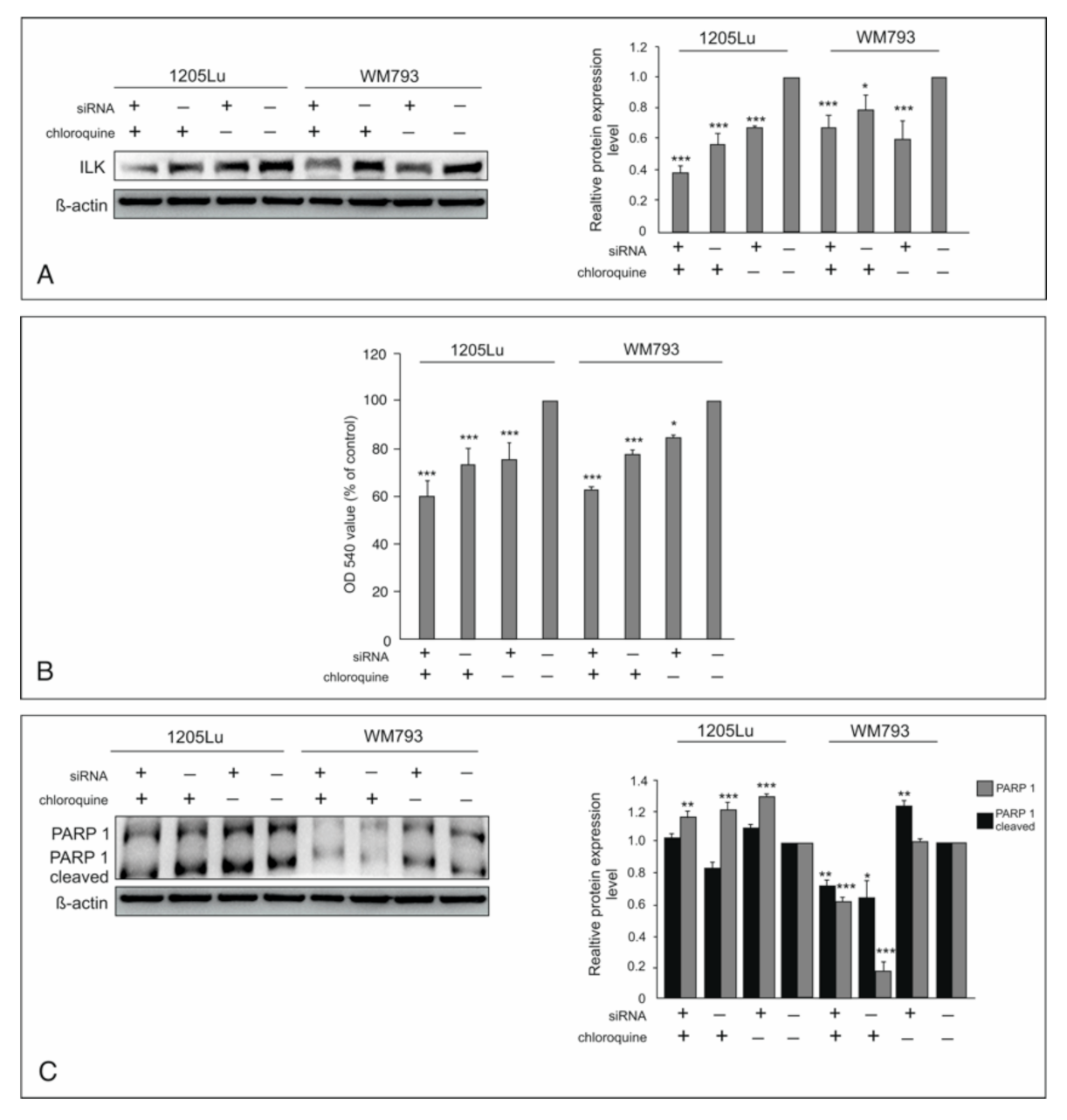
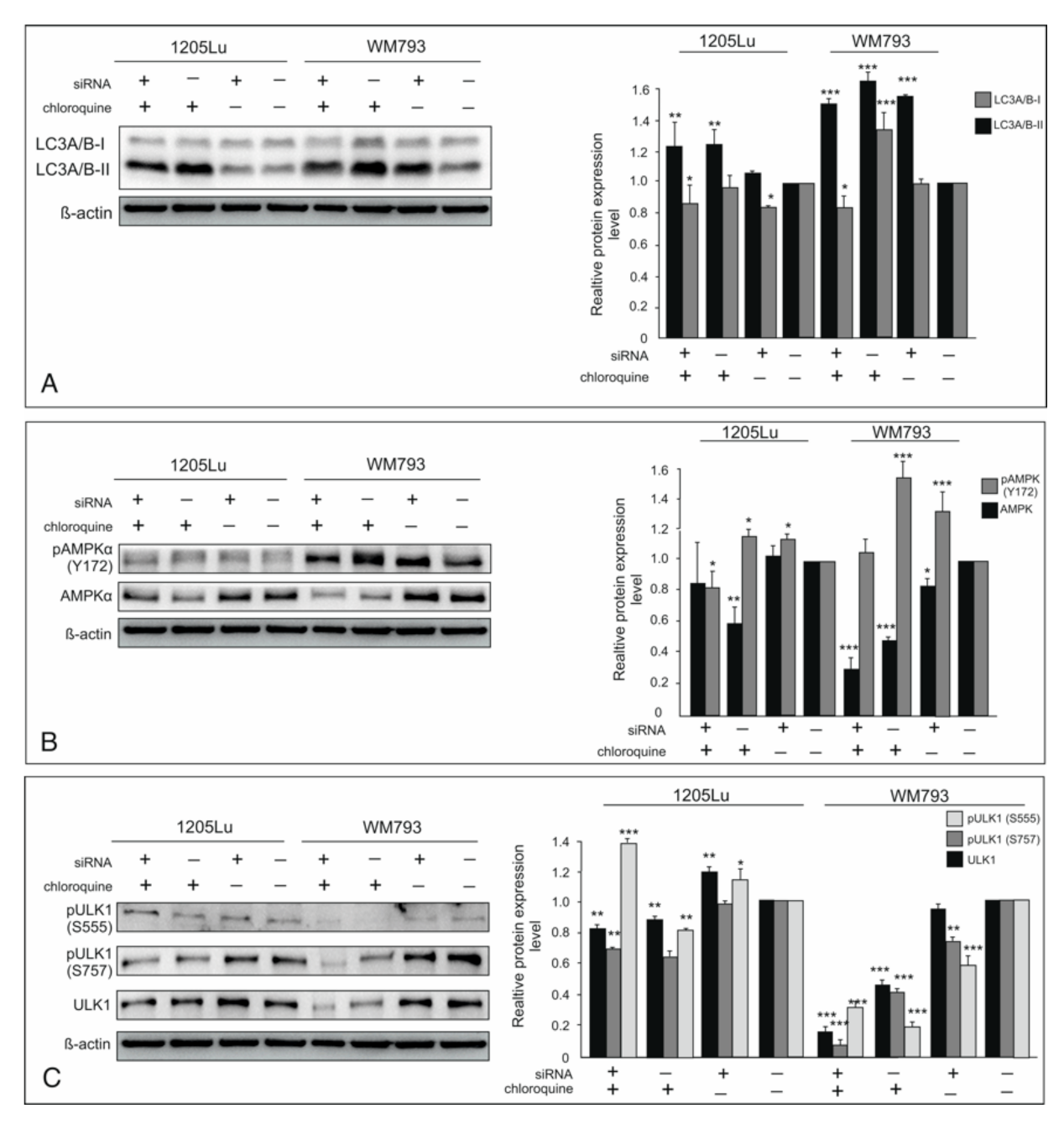
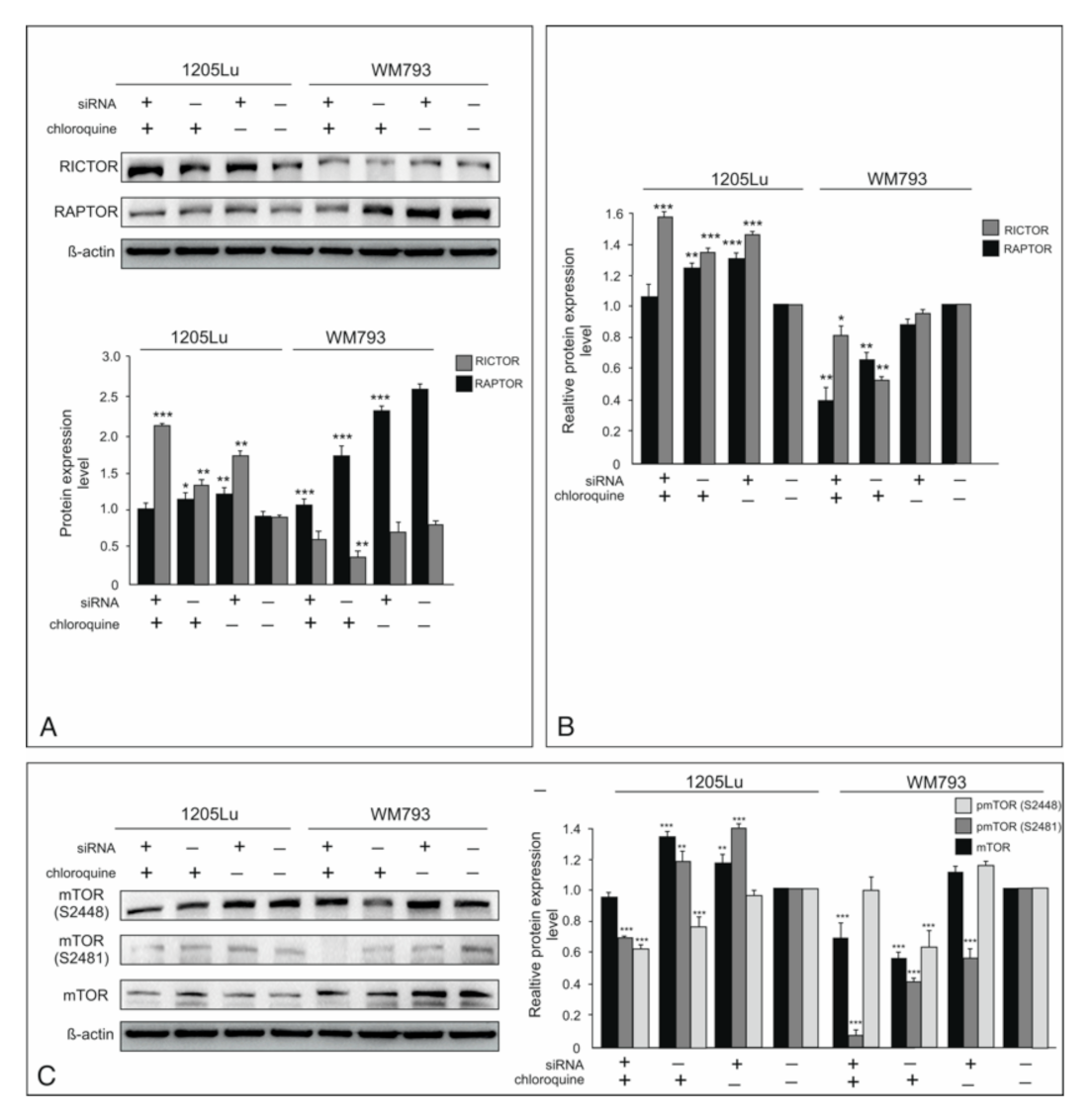

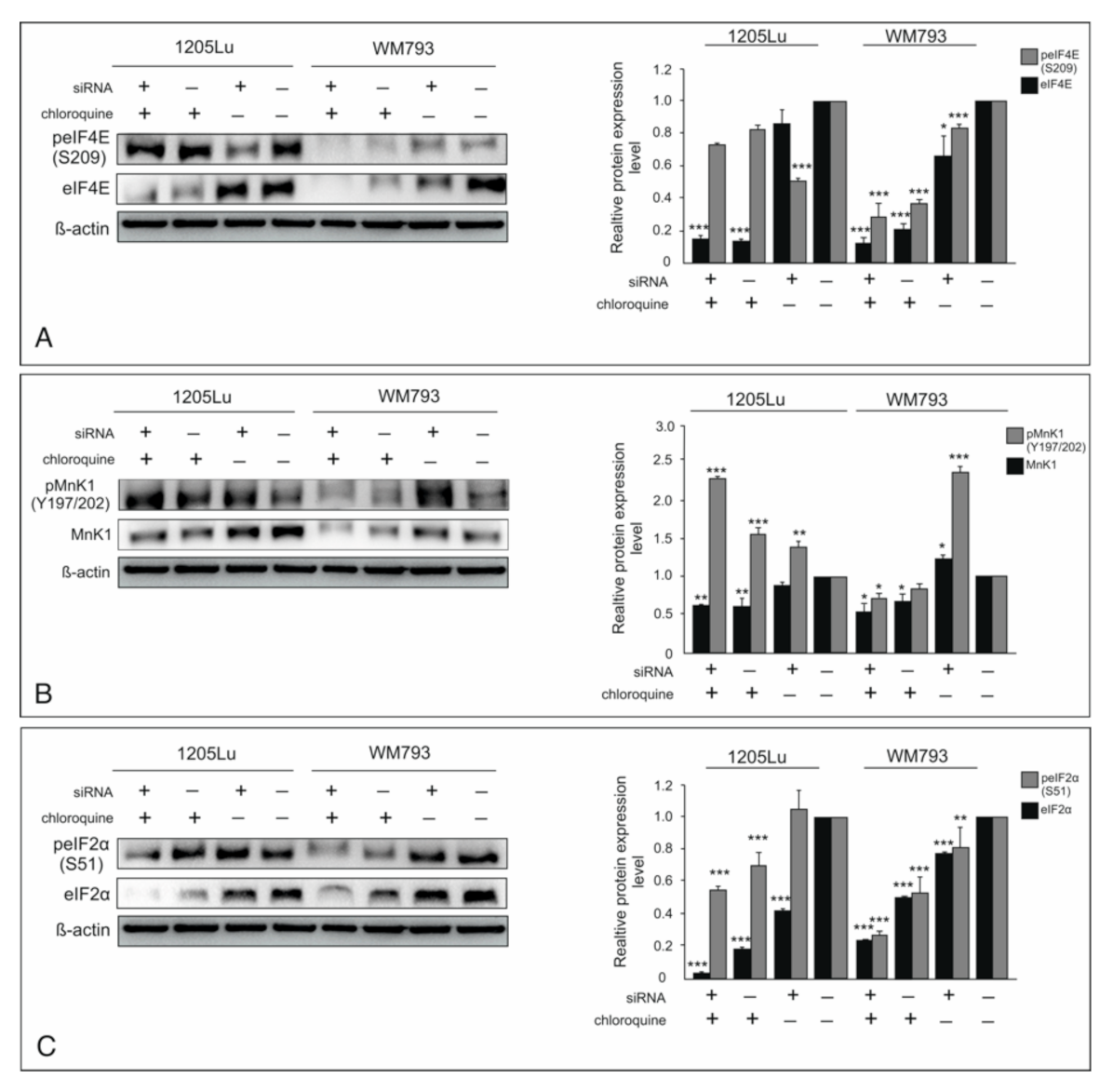
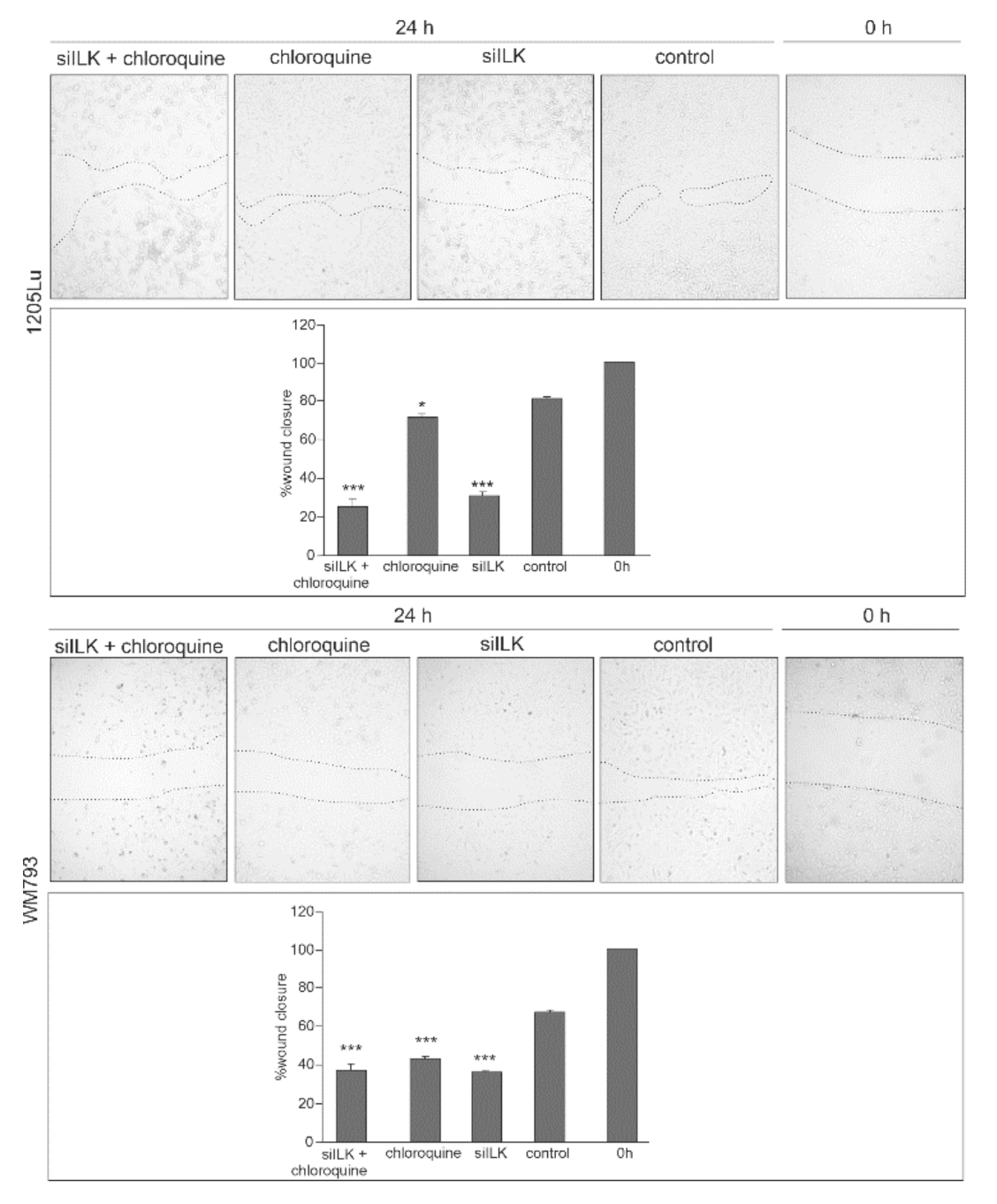
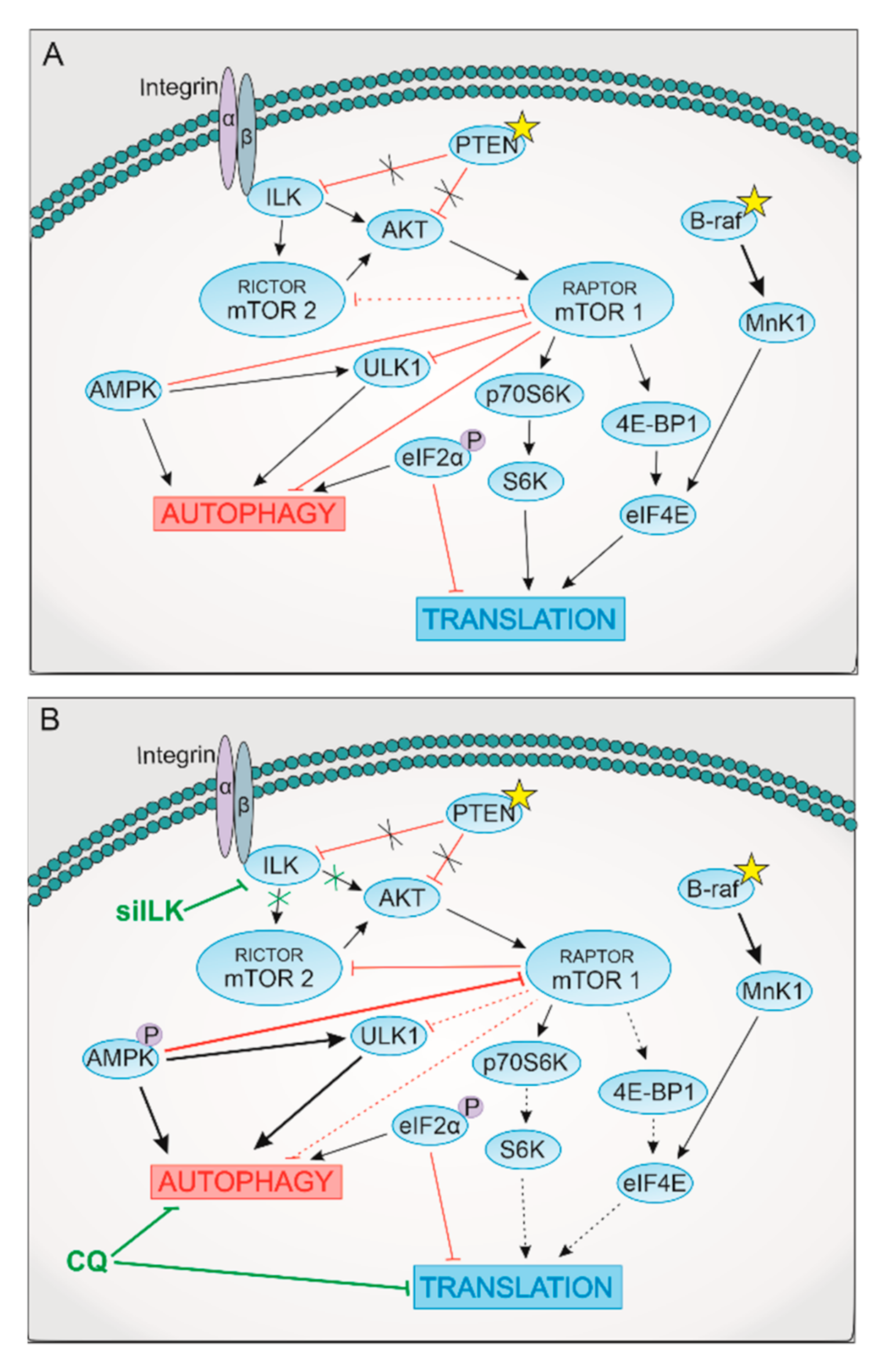
| Primary Antibody | Host Species | Dilution (Application) | Vendor |
|---|---|---|---|
| ILK | mouse | 1:1000 | BD Transduction Laboratories |
| PARP1 | mouse | 1:1000 | Merck |
| LC3A/B | rabbit | 1:1000 | Cell Signaling Technology |
| AMPKα | rabbit | 1:1000 | Cell Signaling Technology |
| AMPKα Y172 | rabbit | 1:1000 | Cell Signaling Technology |
| ULK1 | rabbit | 1:1000 | Cell Signaling Technology |
| ULK1 S555 | rabbit | 1:1000 | Cell Signaling Technology |
| ULK1 S757 | rabbit | 1:1000 | Cell Signaling Technology |
| RICTOR | rabbit | 1:1000 | Cell Signaling Technology |
| RAPTOR | rabbit | 1:1000 | Cell Signaling Technology |
| mTOR S2448 | rabbit | 1:1000 | Cell Signaling Technology |
| mTOR S2481 | rabbit | 1:1000 | Cell Signaling Technology |
| β-actin | mouse | 1:12000 | Sigma Aldrich |
| mTOR | rabbit | 1:1000 | Cell Signaling Technology |
| 70S6K Y389 | rabbit | 1:1000 | Cell Signaling Technology |
| 70S6K | rabbit | 1:1000 | Santa Cruz Biotechnology |
| S6 | rabbit | 1:1000 | Santa Cruz Biotechnology |
| pS6 S235/236 | rabbit | 1:1000 | Cell Signaling Technology |
| p4E-BP1 | rabbit | 1:1000 | Cell Signaling Technology |
| Akt S473 | rabbit | 1:1000 | Cell Signaling Technology |
| Akt | mouse | 1:500 | BD Transduction Laboratories |
| eIF4E S209 | rabbit | 1:1000 | Cell Signaling Technology |
| eIF4E | rabbit | 1:1000 | Santa Cruz Biotechnology |
| pMnK1 | rabbit | 1:1000 | Cell Signaling Technology |
| MnK1 | rabbit | 1:1000 | Cell Signaling Technology |
| eIF2α | rabbit | 1:1000 | Santa Cruz Biotechnology |
| eIF2α S51 | rabbit | 1:1000 | Cell Signaling Technology |
Publisher’s Note: MDPI stays neutral with regard to jurisdictional claims in published maps and institutional affiliations. |
© 2021 by the authors. Licensee MDPI, Basel, Switzerland. This article is an open access article distributed under the terms and conditions of the Creative Commons Attribution (CC BY) license (https://creativecommons.org/licenses/by/4.0/).
Share and Cite
Gil, D.; Laidler, P.; Zarzycka, M.; Dulińska-Litewka, J. Inhibition Effect of Chloroquine and Integrin-Linked Kinase Knockdown on Translation in Melanoma Cells. Int. J. Mol. Sci. 2021, 22, 3682. https://doi.org/10.3390/ijms22073682
Gil D, Laidler P, Zarzycka M, Dulińska-Litewka J. Inhibition Effect of Chloroquine and Integrin-Linked Kinase Knockdown on Translation in Melanoma Cells. International Journal of Molecular Sciences. 2021; 22(7):3682. https://doi.org/10.3390/ijms22073682
Chicago/Turabian StyleGil, Dorota, Piotr Laidler, Marta Zarzycka, and Joanna Dulińska-Litewka. 2021. "Inhibition Effect of Chloroquine and Integrin-Linked Kinase Knockdown on Translation in Melanoma Cells" International Journal of Molecular Sciences 22, no. 7: 3682. https://doi.org/10.3390/ijms22073682
APA StyleGil, D., Laidler, P., Zarzycka, M., & Dulińska-Litewka, J. (2021). Inhibition Effect of Chloroquine and Integrin-Linked Kinase Knockdown on Translation in Melanoma Cells. International Journal of Molecular Sciences, 22(7), 3682. https://doi.org/10.3390/ijms22073682






